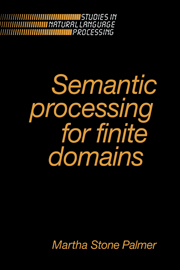Crossref Citations
This Book has been
cited by the following publications. This list is generated based on data provided by Crossref.
Palmer, Martha
1990.
Customizing verb definitions for specific semantic domains.
Machine Translation,
Vol. 5,
Issue. 1,
p.
5.
Dahl, Deborah A.
1992.
Logic Programming in Action.
Vol. 636,
Issue. ,
p.
176.
Taylor, Suzanne Liebowitz
Dahl, Deborah A.
Lipshutz, Mark
Weir, Carl
Norton, Lewis M.
Nilson, Roslyn Weidner
and
Linebarger, Marcia C.
1994.
Integrating natural language understanding with document structure analysis.
Artificial Intelligence Review,
Vol. 8,
Issue. 2-3,
p.
255.
Taylor, Suzanne Liebowitz
Dahl, Deborah A.
Lipshutz, Mark
Weir, Carl
Norton, Lewis M.
Nilson, Roslyn Weidner
and
Linebarger, Marcia C.
1994.
Integration of Natural Language and Vision Processing.
p.
163.
Moulin, Bernard
Gouiaa, Mohamed
and
Delisle, Sylvain
1999.
Conceptual Structures: Standards and Practices.
Vol. 1640,
Issue. ,
p.
168.
Siskind, Jeffrey Mark
2003.
Reconstructing force-dynamic models from video sequences.
Artificial Intelligence,
Vol. 151,
Issue. 1-2,
p.
91.
Stone, Matthew
Doran, Christine
Webber, Bonnie
Bleam, Tonia
and
Palmer, Martha
2003.
Microplanning with Communicative Intentions: The SPUD System.
Computational Intelligence,
Vol. 19,
Issue. 4,
p.
311.
2010.
Semantic Role Labeling.
Ruppenhofer, Josef
Lee-Goldman, Russell
Sporleder, Caroline
and
Morante, Roser
2013.
Beyond sentence-level semantic role labeling: linking argument structures in discourse.
Language Resources and Evaluation,
Vol. 47,
Issue. 3,
p.
695.
Brown, Susan Windisch
Bonn, Julia
Kazeminejad, Ghazaleh
Zaenen, Annie
Pustejovsky, James
and
Palmer, Martha
2022.
Semantic Representations for NLP Using VerbNet and the Generative Lexicon.
Frontiers in Artificial Intelligence,
Vol. 5,
Issue. ,
Palmer, Martha
2024.
My Big, Fat 50-Year Journey.
Computational Linguistics,
Vol. 50,
Issue. 1,
p.
1.



